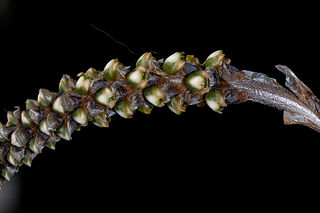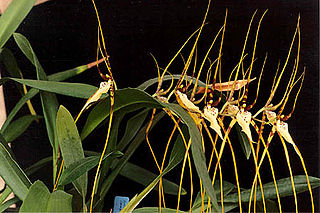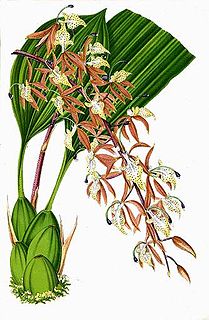
Phragmipedium is a genus of the Orchid family (Orchidaceae) and the only genus comprised in the tribe Phragmipedieae and subtribe Phragmipediinae. The name of the genus is derived from the Greek phragma, which means "division", and pedium, which means "slipper". It is abbreviated 'Phrag' in trade journals.

Aa is a genus of plants of the family Orchidaceae.

Stanhopea is a genus of the orchid family (Orchidaceae) from Central and South America. The abbreviation used in horticultural trade is Stan. The genus is named for the 4th Earl of Stanhope (1781-1855), president of the Medico-Botanical Society of London (1829-1837). It comprises 55 species and 5 natural hybrids. These epiphytic, but occasionally terrestrial orchids can be found in damp forests from Mexico to Trinidad to NW Argentina. Their ovate pseudobulbs carry from the top one long, plicate, elliptic leaf.

Brassia is a genus of orchids classified in the subtribe Oncidiinae. It is native to Mexico, Central America, the West Indies, and northern South America, with one species extending into Florida.

Schomburgkia is a genus of plants belonging to the family Orchidaceae. This genus is named for Richard Schomburgk, a German botanist who explored British Guiana during the 19th century. Species in this genus are either epiphytic or lithophytic in their growth habit. According to the Royal Horticultural Society Schom. is the official abbreviation for this genus.

Ponthieva is a genus from the orchid family (Orchidaceae). They are named after Henry de Ponthieu, an English merchant of Huguenot ancestry who sent West Indian plant collections to Sir Joseph Banks in 1778.

Huntleya is a small orchid genus native to South America, Central America and Trinidad.

Corymborkis, commonly known as cinnamon orchids, or 管花兰属 is a genus of eight species of orchids in the family Orchidaceae. They are evergreen, terrestrial plants which grow in clumps and have thin roots, leafy stems, pleated leaves and widely-opening flowers with thin, spreading sepals and petals. They are widely distributed in the tropics.

Rodriguezia, abbreviated Rdza. in the horticultural trade, is a genus of orchids. It consists of 49 known species, native to tropical America from southern Mexico and the Windward Islands south to Argentina, with many of the species endemic to Brazil.

Polycycnis, abbreviated in horticultural trade as Pcn, is a genus of orchid, comprising 17 species found in Central America, and northern South America.

Sievekingia is a genus of orchid, comprising 20 species found in Central and South America, from Nicaragua east to the Guianas and south to Bolivia.

Caucaea is a genus of flowering plants from the orchid family, Orchidaceae. It contains 9 currently recognized species, all native to northwestern South America.
- Caucaea alticola(Stacy) N.H.Williams & M.W.Chase - Ecuador
- Caucaea andigena(Linden & Rchb.f.) N.H.Williams & M.W.Chase - Ecuador
- Caucaea macrotyle(Königer & J.Portilla) Königer - Ecuador
- Caucaea nubigena(Lindl.) N.H.Williams & M.W.Chase - Ecuador, Colombia, Venezuela, Peru
- Caucaea olivacea(Kunth) N.H.Williams & M.W.Chase - Ecuador, Colombia
- Caucaea phalaenopsis(Linden & Rchb.f.) N.H.Williams & M.W.Chase - Ecuador, Colombia
- Caucaea radiata(Lindl.) Mansf. - Ecuador, Colombia, Venezuela
- Caucaea sanguinolenta(Lindl.) N.H.Williams & M.W.Chase - Ecuador, Colombia, Venezuela
- Caucaea tripterygia(Rchb.f.) N.H.Williams & M.W.Chase - Ecuador, Peru

Cischweinfia is a genus of flowering plants from the orchid family, Orchidaceae. It was named after Harvard orchidologist Charles Schweinfurth. It has eleven currently recognized species, all native to Central America and northwestern South America.

Trichoceros is a genus of flowering plants from the orchid family, Orchidaceae. The genus is endemic to South America.

Ionopsis is a genus of flowering plants from the orchid family, Orchidaceae. It contains 6 currently accepted species, native to Latin America, the West Indies, and Florida.
- Ionopsis burchelliiRchb.f. - Brazil
- Ionopsis minutiflora(Dodson & N.H.Williams) Pupulin - Ecuador
- Ionopsis papillosaPupulin - Ecuador
- Ionopsis satyrioides(Sw.) Rchb.f. in W.G.Walpers - widespread across southern Mexico, Central America, the West Indies, and South America
- Ionopsis utricularioides(Sw.) Lindl. - widespread across southern Mexico, Central America, the West Indies, South America, and Florida
- Ionopsis zebrinaKraenzl. - Colombia

Koellensteinia is a genus of flowering plants from the orchid family, Orchidaceae. It is named by Heinrich Gustav Reichenbach for the Captain Carl Kellner von Koellenstein, an Austrian military officer and a botanical correspondent of Reichenbach.

Macradenia is a genus of flowering plants from the orchid family, Orchidaceae. It is native to Latin America, the West Indies and Florida.
- Macradenia amazonicaMansf. - Brazil
- Macradenia brassavolaeRchb.f. - southern Mexico, Central America, Colombia, Venezuela, Ecuador
- Macradenia delicatulaBarb.Rodr. - Minas Gerais
- Macradenia loxoglottisFocke ex Rchb.f. in W.G.Walpers - Suriname
- Macradenia lutescensR.Br. - Florida, Bahamas, Cuba, Dominican Republic, Jamaica, Trinidad, Venezuela, Colombia, Guyana, Suriname, French Guiana, Brazil, Colombia, Ecuador
- Macradenia multiflora(Kraenzl.) Cogn. in C.F.P.von Martius - Brazil, Paraguay
- Macradenia paraensisBarb.Rodr. - Brazil, Paraguay
- Macradenia paulensisCogn. in C.F.P.von Martius - Brazil
- Macradenia purpureorostrataG.Gerlach - Colombia, Venezuela
- Macradenia regnelliiBarb.Rodr. - Minas Gerais
- Macradenia rubescensBarb.Rodr. - Brazil, Venezuela
- Macradenia tridentataC.Schweinf. - Peru

Pescatoria is a genus of flowering plants from the orchid family, Orchidaceae. It is native to Costa Rica, Panama, and northern South America.
Pseudocentrum is a genus of flowering plants from the orchid family, Orchidaceae. It is native to Central America, the West Indies and northern South America.
Rhetinantha is a genus of orchids native to Mexico, South America and Central America.
- Rhetinantha aciantha(Rchb.f.) M.A.Blanco - widespread from southern Mexico to Brazil
- Rhetinantha acuminata(Lindl.) M.A.Blanco - Venezuela, Colombia, Ecuador, Peru
- Rhetinantha cerifera(Barb.Rodr.) M.A.Blanco - Venezuela, Colombia, Brazil, Peru, Bolivia
- Rhetinantha divaricata(Barb.Rodr.) M.A.Blanco - Brazil, Peru, Bolivia
- Rhetinantha encyclioides(J.T.Atwood & Dodson) M.A.Blanco - Ecuador
- Rhetinantha friedrichsthalii(Rchb.f.) M.A.Blanco - Central America, Yucatán Peninsula
- Rhetinantha mariaisabeliae(J.T.Atwood) M.A.Blanco - Bolivia
- Rhetinantha monacensis(Kraenzl.) M.A.Blanco - Venezuela, Colombia
- Rhetinantha neilii(Dodson) M.A.Blanco - Ecuador
- Rhetinantha notylioglossa(Rchb.f.) M.A.Blanco - Venezuela, Colombia, Brazil, Peru, Bolivia, Ecuador
- Rhetinantha ophiodens(J.T.Atwood) M.A.Blanco - Bolivia
- Rhetinantha pastorellii(D.E.Benn. & Christenson) M.A.Blanco - Ecuador, Peru
- Rhetinantha schistostele(Schltr.) M.A.Blanco - Costa Rica
- Rhetinantha scorpioidea(Kraenzl.) M.A.Blanco - widespread from southern Mexico to Brazil
- Rhetinantha witsenioides(Schltr.) M.A.Blanco - Colombia, Ecuador, Peru


















